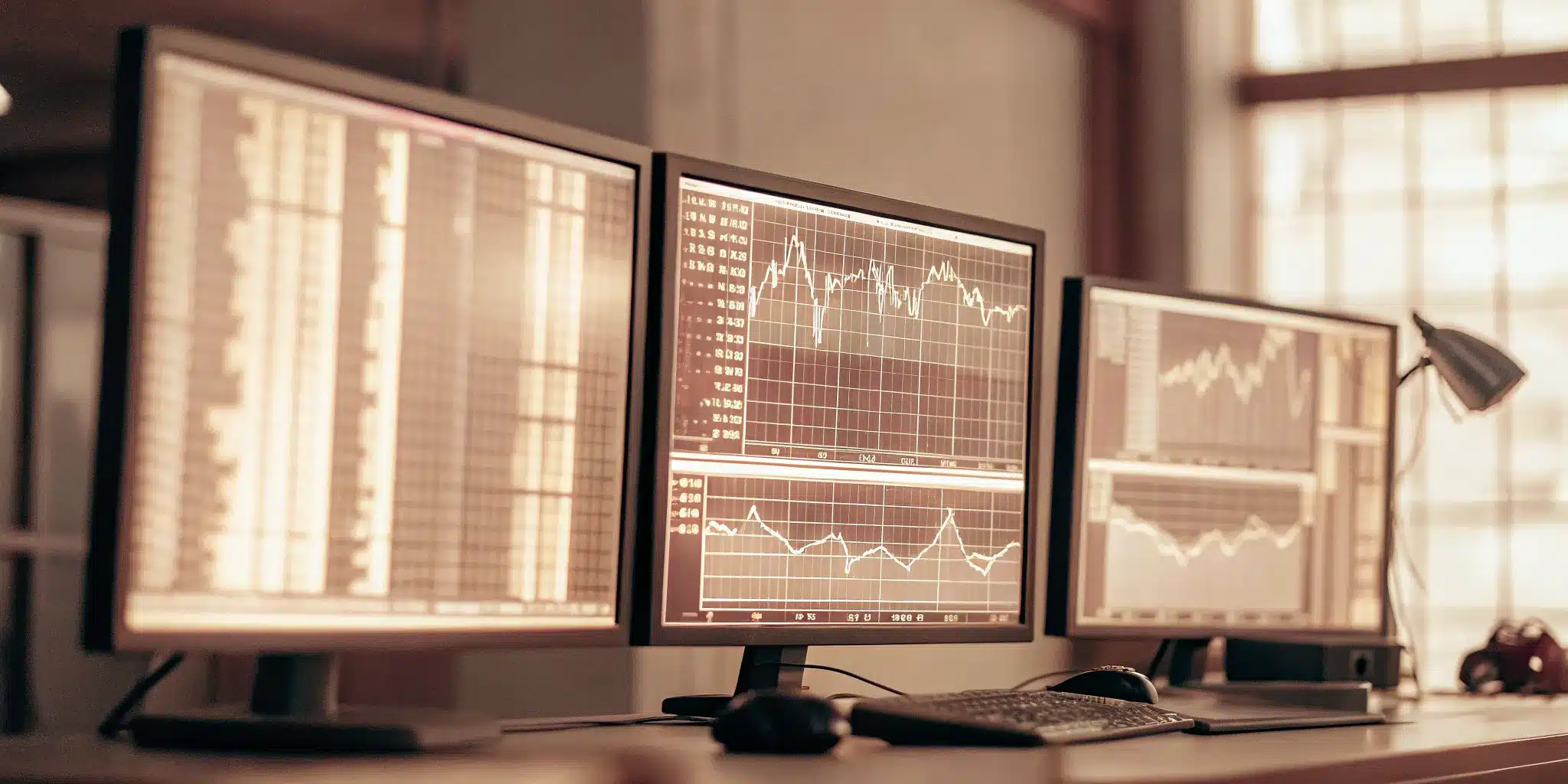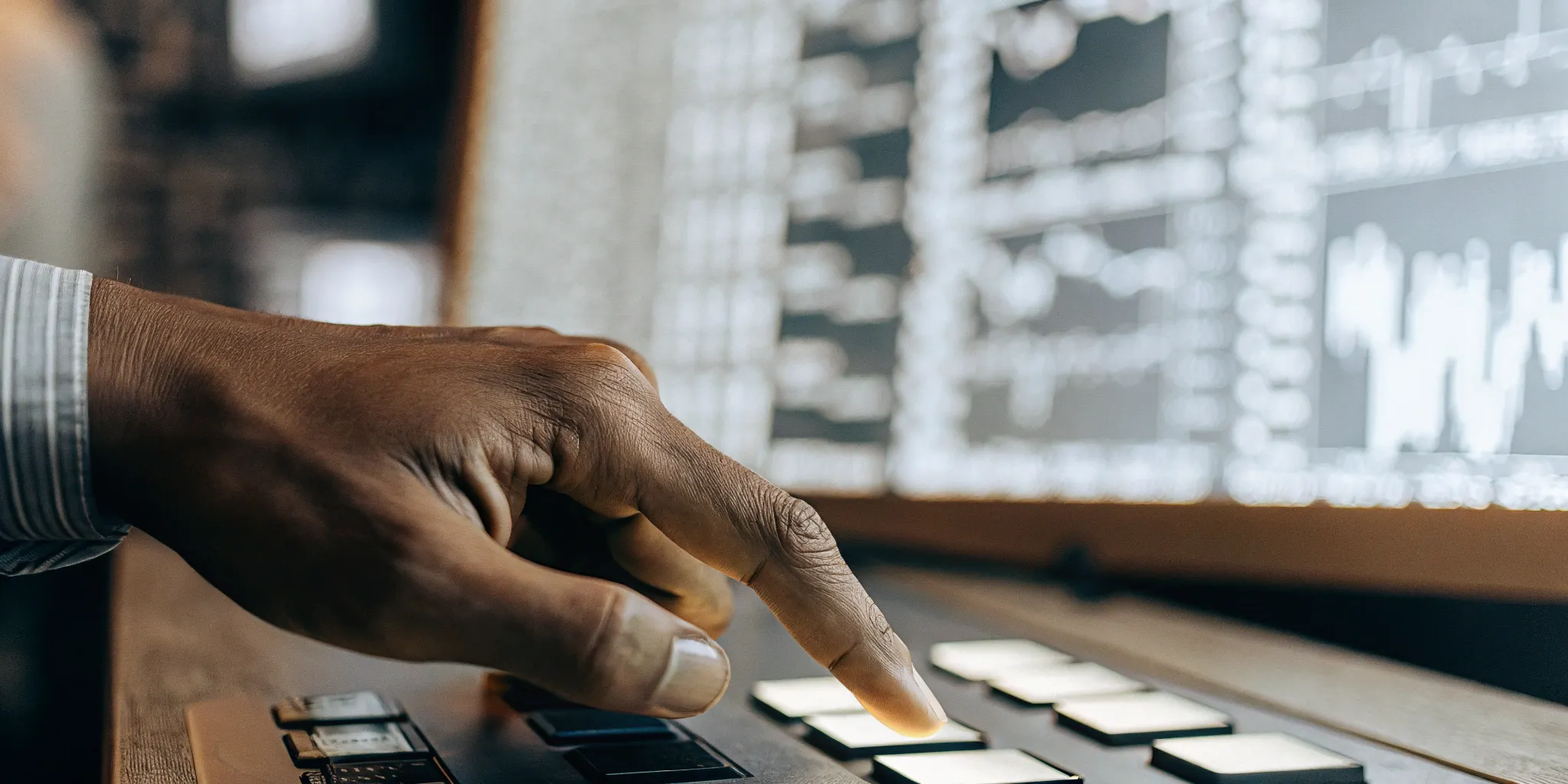The financial markets are a complex and dynamic environment, demanding constant attention and quick decision-making. For traders seeking an edge, algo trading offers a powerful solution. By automating trading strategies, algorithms can execute trades with speed and efficiency far beyond human capability. This guide delves into the world of algo trading, exploring its advantages and disadvantages, popular strategies, and the essential tools and skills needed to succeed. Whether you’re looking to reduce human error, capitalize on fleeting opportunities, or simply gain a deeper understanding of this transformative technology, this guide is your starting point.
Key Takeaways
- Automated trading removes human emotion from investing. Algorithms execute trades based on pre-defined rules, leading to faster, more disciplined trading.
- Building a successful automated trading system requires a blend of market knowledge and technical skills. You’ll need to understand financial markets, choose a suitable platform, develop your trading strategy, and backtest it thoroughly.
- Risk management and continuous learning are essential for long-term success in algo-trading. Implement stop-loss orders, manage your position size, monitor your algorithms in real time, and stay informed about emerging trends and technologies.
What is Algorithmic Trading?
Algorithmic trading, often called algo-trading or automated trading, uses computer programs to execute trades based on pre-defined rules. Think of it as putting your trading on autopilot. These programs, powered by sophisticated algorithms, analyze market data, identify opportunities, and place trades much faster and more frequently than any human could. This makes algo-trading a powerful tool for both individual investors and large financial institutions. For a helpful introduction to the basics, check out this Investopedia article on algorithmic trading.
Definition and Core Concepts
At its core, algorithmic trading removes human emotion and bias from trading. Instead of relying on gut feelings, algorithms follow a strict set of instructions. These instructions consider factors like price movements, trading volume, and even news events to trigger buy or sell orders. This rule-based approach allows for greater precision and consistency. Wikipedia offers a comprehensive look at algorithmic trading.
The power of algo-trading lies in its ability to react to market changes instantly. Algorithms can monitor multiple markets simultaneously, identify fleeting opportunities, and execute trades within milliseconds. This speed and efficiency are simply impossible for human traders to match. If you’re interested in getting started, uTrade Algos provides a step-by-step guide.
How Algorithms Impact Financial Markets
The rise of algorithmic trading has significantly changed financial markets. On the one hand, it has increased market liquidity, making it easier and cheaper to buy and sell assets. This benefits all market participants. However, algo-trading has also been associated with increased market volatility and flash crashes, like the one in 2010. This Wikipedia article also discusses the potential downsides.
Algorithms can analyze vast amounts of data in real-time, executing trades far faster and more efficiently than traditional methods. This speed and efficiency have transformed how markets operate, driving the need for faster technology and more sophisticated algorithms. FN Capital’s own research on the algorithmic revolution explores how algorithms are reshaping financial markets.
How Does Algorithmic Trading Work?
Algorithmic trading automates buying and selling assets based on pre-defined rules. These rules, often encoded into computer programs, dictate how, when, and at what price trades are executed. This automation removes emotional decision-making, allowing for faster, more disciplined trading. Think of it as your personal trading assistant, working tirelessly in the background to execute your strategy.
Mechanics of Automated Trades
Imagine instructing a computer to buy a certain stock when its price dips below a specific level. That’s algorithmic trading in action. Computer programs execute these trades with speed and frequency far beyond human capability. These “algorithms” can be simple, based on basic price movements, or incredibly complex, incorporating vast amounts of data and sophisticated mathematical models. As Investopedia explains in their introduction to algorithmic trading, these rules can be based on price fluctuations, trading volume, specific times, or a combination of factors. This allows traders to react to market changes in milliseconds, capitalizing on opportunities that would otherwise be missed.
Key Components of an Algo Trading System
Building a successful algorithmic trading system involves several key steps. A solid understanding of financial markets is essential. You’ll then choose the asset class you want to trade—stocks, forex, cryptocurrencies, or others. Next, select a trading platform and a programming language to build your algorithms. The core of your system is your trading strategy, which you’ll need to backtest using historical data. Finally, deploy your algorithm for live trading, constantly monitoring its performance and making adjustments. uTrade Algos offers a helpful step-by-step guide to get started. From high-frequency trading (HFT) to arbitrage, numerous strategies are available, as outlined on Wikipedia’s page about algorithmic trading. Each strategy has its own rules and complexities, so finding the right one for your goals and resources is crucial.
Advantages and Disadvantages of Algorithmic Trading
Algorithmic trading, often hailed as a revolutionary force in finance, presents a mix of compelling advantages and potential drawbacks. Understanding both sides is crucial for anyone considering this automated approach.
Speed, Efficiency, and Reduced Human Error
One of the most significant benefits of algorithmic trading is its sheer speed. Algorithms execute trades in milliseconds, far surpassing human capability. This speed allows traders to capitalize on fleeting price changes that would otherwise be missed. As Investopedia explains, the goal is to generate profits systematically, removing human emotions and increasing market liquidity. This speed and efficiency translate into more opportunities and potentially higher returns. Moreover, computers eliminate human errors, like typos in order quantities, leading to more precise trades. This precision minimizes the risk of costly mistakes and ensures trades are executed according to the defined strategy.
Technology Dependence and Market Impact
While algorithmic trading offers undeniable advantages, it also comes with potential downsides. A primary concern is the inherent dependence on technology. Internet outages, system failures, or software glitches can disrupt trading and potentially lead to losses. Furthermore, large algorithmic trades can inadvertently influence market volatility, creating unpredictable swings. The sheer volume of automated trades can sometimes exacerbate market fluctuations, creating both opportunities and risks. Therefore, careful consideration of these technological dependencies and potential market impacts is essential for successful algorithmic trading.
Popular Algorithmic Trading Strategies
Algorithmic trading encompasses a variety of strategies, each designed to capitalize on different market dynamics. Let’s explore some of the most common approaches:
Trend-Following and Mean Reversion
Trend-following strategies aim to profit from sustained price movements. These algorithms identify assets experiencing upward trends and buy them, anticipating continued price appreciation. Conversely, they sell assets exhibiting downward trends, aiming to avoid further losses. This approach assumes that trends, once established, will persist.
Mean reversion strategies operate on a different principle. They assume that asset prices tend to fluctuate around a historical average. When prices deviate significantly from this average, the algorithm bets that they will eventually revert. This means buying undervalued assets (expecting their price to rise) and selling overvalued assets (expecting their price to fall). Learn more about the basics of algorithmic trading, including trend-following and mean reversion.
Arbitrage and High-Frequency Trading
Arbitrage strategies exploit price discrepancies for the same asset across different markets. If an asset is priced lower on one exchange and higher on another, the algorithm buys the asset on the cheaper exchange and simultaneously sells it on the more expensive one, pocketing the difference. This strategy relies on speed and efficient market access to capture these fleeting opportunities.
High-frequency trading (HFT) takes speed to the extreme. These algorithms execute a massive volume of orders at incredibly high speeds, often taking advantage of tiny price inefficiencies that exist for mere milliseconds. HFT strategies require sophisticated technology and low-latency connections to succeed. Algorithmic trading, including HFT and arbitrage, has become a significant force in modern financial markets.
Essential Tools and Skills for Algo Traders
Successfully navigating the world of algo trading requires a blend of technical know-how and market understanding. Let’s break down the essentials you’ll need to develop and implement effective automated trading strategies.
Programming Languages and Backtesting Platforms
A foundational element of algo trading is coding your strategies. Languages like Python are popular choices due to their extensive libraries for data analysis and financial modeling. Choosing the right programming language is your first step. Next, you’ll need a robust backtesting platform. Backtesting lets you simulate your strategies against historical market data, identifying potential flaws and optimizing performance before risking real capital. Think of it as your testing ground where you refine your algorithms to withstand various market conditions.
Data Analysis and Market Expertise
While automation is at the heart of algo trading, human intelligence plays a crucial role. A deep understanding of financial markets is essential for developing sound trading strategies. You’ll need to analyze market trends, identify opportunities, and understand the factors that influence asset prices. This market expertise informs the logic you’ll encode into your algorithms. Equally important is data analysis. You’ll be working with large datasets, so proficiency in statistical analysis and data visualization is key. This allows you to extract meaningful insights from market data, validate your trading ideas, and continuously improve your algorithms. Remember, even with automated systems, unforeseen market events can impact your results, highlighting the importance of ongoing monitoring and adjustment.
Manage Risk in Algorithmic Trading
Algorithmic trading, while offering significant advantages, isn’t without its risks. A well-defined risk management strategy is crucial for protecting your capital and ensuring long-term success. This involves understanding potential downsides and implementing safeguards to mitigate losses. Let’s explore two key aspects of effective risk management in algo trading.
Implement Stop-Loss and Position Sizing
One of the most fundamental risk management tools is the stop-loss order. This order automatically sells an asset when it reaches a predetermined price, limiting potential losses. Think of it as your safety net, preventing a small dip from turning into a significant loss. Equally important is position sizing—determining how much capital to allocate to each trade. By carefully managing your position size, you avoid overexposure to any single asset, protecting your portfolio from significant drawdowns. Experts at uTrade Algos emphasize these practices as essential for mitigating potential risks.
Monitor and Assess Risk in Real Time
While algorithmic trading systems operate autonomously, continuous monitoring is essential. Market conditions can change rapidly, and a strategy that performed well yesterday might be unsuitable today. Real-time risk assessment allows you to adjust your algorithms dynamically, responding to market fluctuations and unforeseen events. This active oversight helps ensure your trading strategies remain effective and adaptable. As highlighted by uTrade Algos, relying solely on automated systems without human intervention can lead to unanticipated losses, especially during periods of market volatility. Regularly reviewing and adjusting your algorithms is key to navigating the ever-changing market landscape.
Start with Algorithmic Trading
Getting started with algorithmic trading might seem daunting, but by breaking it down into smaller steps, you can begin automating your trades and working toward your financial goals. This section covers the fundamentals to get you started.
Learn Trading and Programming Fundamentals
Before diving into algorithmic trading, it’s essential to build a solid foundation in both trading and programming. Understanding how financial markets work is crucial. This includes choosing an asset class (stocks, forex, crypto, etc.) and selecting a trading platform. You’ll also want to grasp basic programming concepts. Python is often the language of choice for algo trading because of its extensive libraries and supportive community. As you learn, focus on developing a trading strategy: define clear entry and exit rules, explore technical indicators, and establish risk management parameters. Backtesting your strategy lets you see how your algorithm would have performed historically, helping you refine it before risking real capital. Finally, when you’re ready to go live, start small, monitor closely, and be prepared to adjust your algorithm as needed. For more information, check out resources like Investopedia for helpful guides and explanations.
Choose a Platform and Develop Your First Algorithm
Once you have a grasp of the basics, the next step is selecting a platform to build and deploy your algorithms. Several platforms cater to algo traders, offering different features and levels of complexity. Research various platforms like Zerodha Streak, uTrade Algos, and Upstox Algo Lab to find one that aligns with your needs and technical skills. These platforms often provide pre-built tools and resources to simplify creating and implementing algorithms. When developing your first algorithm, start with a simple strategy. A basic trend-following or mean-reversion algorithm can be a good starting point. Focus on clearly defining the rules for entering and exiting trades and ensure your algorithm includes appropriate risk management measures, such as stop-loss orders. Remember, the goal is to build a functional algorithm and gain practical experience. You can always refine and optimize your strategies as you become more comfortable with the process. uTrade Algos offers a helpful step-by-step guide for getting started.

Common Mistakes and How to Avoid Them
Even with the best tools, algorithmic trading has potential pitfalls. Knowing the common mistakes can save you time and money. This section covers two areas where traders often stumble: overfitting and inadequate backtesting, and maintaining your strategy.
Overfitting and Inadequate Backtesting
Overfitting happens when your algorithm performs flawlessly on historical data but fails in live markets. It’s like training a robot to solve a maze using a specific map—it might ace that map, but get lost in any other maze. Your algorithm becomes too tailored to past data and can’t adapt to new market conditions. Avoid this by testing your algorithm on a separate set of data it hasn’t “seen” before, ensuring it can generalize and perform well in real-world scenarios. Think of it as giving your robot a new maze to solve.
Another common mistake is inadequate backtesting. Backtesting simulates your algorithm’s performance on historical data. However, many traders forget to factor in real-world costs like fees, slippage (the difference between the expected price and the actual execution price), and the spread. Always include these in your backtests to get a realistic picture of potential profits. A profitable backtest that ignores these factors can quickly turn sour in live trading.
Maintain Your Strategy
Once your algorithm is live, the work doesn’t stop. Many new algo traders fall into the trap of overcomplicating their algorithms. They assume complexity equals better results, but often, a simpler strategy is more robust and easier to manage. Resist the urge to constantly tweak your algorithm unless you have solid, data-backed reasons. Focus on a sound strategy, rather than chasing complexity.
Regularly review your strategy, even if it’s performing well. Market conditions change, and what worked yesterday might not work tomorrow. Set aside time to analyze your algorithm’s performance, identify any weaknesses, and make necessary adjustments. This ongoing maintenance is crucial for long-term success in algo trading. Remember, even the most sophisticated algorithms need human oversight to stay ahead of the curve. Regular strategy reviews can help you identify potential problems before they impact your bottom line. Algorithms, much like carefully maintained gardens, require tending to thrive.
The Future of Algorithmic Trading
The world of finance is constantly evolving, and algorithmic trading is no exception. As technology advances, we’re seeing exciting new trends emerge, shaping the future of automated trading. Let’s explore what lies ahead.
Emerging Trends and Technologies
Algorithmic trading is already transforming financial markets, bringing increased speed and precision. Algorithms can analyze massive datasets in real time, executing trades far more efficiently than traditional methods. This allows traders to capitalize on fleeting market opportunities and manage risk more effectively. We’re also witnessing a rise in accessibility, empowering both seasoned professionals and newcomers to leverage the power of automated precision. As algorithms become more sophisticated, we can expect even greater efficiency and more refined trading strategies.
The Impact of AI and Machine Learning
Artificial intelligence and machine learning play an increasingly crucial role in the evolution of algo trading. These technologies offer the ability to analyze complex market patterns, adapt to changing conditions, and continuously refine trading strategies. At FN Capital, we’re at the forefront of this innovation, developing cutting-edge AI and automated trading strategies that push the boundaries of what’s possible. Imagine a system that not only identifies market trends but also learns and improves over time, constantly optimizing its performance. That’s the power of AI in algorithmic trading. As these technologies mature, we can anticipate a future where algorithms become even more intelligent and adaptable, leading to more profitable and sophisticated trading outcomes. The future of algo trading is bright, with continuous improvements on the horizon as algorithms learn from ever-increasing amounts of market data.
Related Articles
- How Algorithmic Trading Works: An Overview – FN Capital
- Algorithmic Trading: Your Complete Guide – FN Capital
- Best Trading Algorithms for Sale: A Practical Guide – FN Capital
- Algorithmic vs. Manual Trading: Which Is Best? – FN Capital
- What is Automated Trading Software? Your Guide to Algorithmic Trading – FN Capital
Frequently Asked Questions
Is algorithmic trading only for professional traders?
Not at all! While institutional investors use complex algorithms, user-friendly platforms are making algo trading accessible to everyone. These platforms often offer pre-built strategies and intuitive interfaces, allowing beginners to automate their trades without extensive coding knowledge. Even with limited experience, you can leverage the speed and efficiency of algorithmic trading.
What are the biggest risks of algorithmic trading?
Like any investment strategy, algo trading has inherent risks. Technical issues like internet outages or software glitches can disrupt trades. Market volatility can also impact algorithm performance, especially if the strategy isn’t designed to handle rapid price swings. Over-reliance on backtested results without considering real-world factors like fees and slippage can also lead to unexpected losses. A robust risk management plan, including stop-loss orders and careful position sizing, is crucial.
How much coding knowledge do I need to get started?
The level of coding knowledge required depends on your approach. If you’re using a platform with pre-built strategies, you might not need any coding skills at all. However, if you want to develop your own custom algorithms, learning a language like Python is beneficial. Many resources are available online to help you learn, even with no prior coding experience.
What’s the difference between algorithmic trading and manual trading?
Manual trading involves making trade decisions yourself, based on your market analysis and judgment. Algorithmic trading automates this process, using computer programs to execute trades based on pre-defined rules. This removes emotional bias, allows for faster execution, and enables traders to monitor multiple markets simultaneously.
How can I improve the performance of my trading algorithms?
Regularly reviewing and refining your algorithms is key. Thorough backtesting on historical data helps identify potential weaknesses and optimize performance before live trading. Continuously monitoring your algorithm’s performance in real-time allows you to adapt to changing market conditions and make necessary adjustments. Avoid overfitting your algorithm to past data, and ensure your backtests account for real-world costs like fees and slippage.





